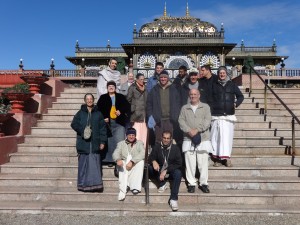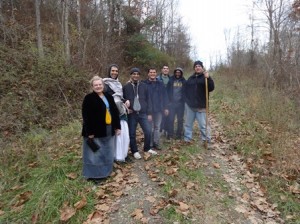New Vrindaban Makes Steady Progress in Exciting New Phase
by Madhava Smullen
New Vrindaban, established in 1968 by ISKCON Founder Srila Prabhupada as his society’s first rural community, is continuing its transition into an exciting new phase.
After a series of pioneering attempts in the early years, the community struggled for decades with a dedicated core crew.
But since spring 2011, a renewed effort has been made to revitalize New Vrindaban and refocus on becoming the exemplary self-sufficient, Krishna conscious community that Srila Prabhupada envisioned.
Brought in to assist with the transition was new community president Jaya Krsna Das, formerly the administrative director for Bhaktivedanta College, Belgium.
Other key personnel were also introduced and department staff rearranged, creating an atmosphere of freshness and rebirth.
A dozen devotees discussed some of the resulting developments at the Bi-Annual New Vrindaban Board Meetings, held in Gopal’s Garden Day School from November 8th through 10th this fall.
ISKCON Governing Body Commissioners Anuttama Das, Malati Dasi and Tamohara Das joined board members from non-profits ISKCON New Vrindaban and ECO-Vrindaban, which focuses on the community’s self sufficiency efforts.
The meetings began at 10:00am on Friday, with a team of thirteen department heads all delivering reports for 2013.
“Although 2013 is a transitional year, the reports were mostly positive,” says board member Chaitanya Mangala Das. “Last year, the departments were mostly understaffed and devotees overworked, tired and burnt out. This year was still a tough one, but with the new people and energy, everyone felt the enthusiasm growing.”
One of the most consistently understaffed and overworked departments over the years has been the Pujari (Priest) Department. But this year, head Abhinandana Das put in a lot of time to help the pujaris develop good working relationships amongst each other. And three new priests have come on board, offering relief to the core team.
Also benefitting from new leadership was the congregational development department. With twenty years of professional experience in the field, department head Bhakta Josef has garnered praise for making the service easier and more organized, and for improving the relationships of devotees working within it.
Meanwhile Vasudeva Das, who oversees New Vrindaban’s Palace Lodge for visitors, reported a complete renovation of the entire second floor. Devotees replaced the old wooden panelling with sheetrock, painted the walls, and installed new floors. They also replaced all the lighting fixtures and electric sockets and equipped rooms with new beds, tables, dressers and closets, creating modern motel-level accommodations.
Since the changes, Vasudeva reported, guests have repeatedly commented on how much more pleasant and comfortable their stays have been.
Govinda’s Restaurant has also been fully renovated under Nityodita Das’s leadership. The new management, crew and menus excited community members and guests.
Renovations have begun too at Srila Prabhupada’s Palace, one of only three Samadhis (memorials) for the ISKCON Founder Acharya in the world. The front steps of the Palace are being rebuilt with granite instead of concrete, and plans are underway to renovate the outside wall, the four corner chattras and the entrance walkway for ISKCON’s 50th anniversary in 2016. The developments had Tripad Das, Palace caretaker since 1985, enthusing that he felt more enlivened than he had in many years.
The most important part of a community is, of course, the people, and in its transition New Vrindaban is also making an effort to focus on devotee care. In the last year, the head of this department Lilasuka Dasi acted as a liaison between community president Jaya Krsna and other devotees; helped devotees get health care; facilitated visits by homeopathic doctor Visvadhika Dasi; and provided young couples with the training to work together and support each other.
Department Heads for Communications, Facilities, Festivals, Land Management, Accounting, and the Ladies’ Ashram also provided reports detailing their achievements in the past year.
Following these, Friday afternoon was spent hearing reports from the various non-profit entities operating in and around New Vrindaban.
Gopal’s Garden representative Ruci Dasi reported that the homeschool co-op is now in its seventh year. This year four students, aged five to eleven, attended and were taught a standard public school curriculum with Krishna conscious elements.
The school is largely funded by the ISKCON New Vrindaban and Eco-Vrindaban boards, who firmly believe that although it is small now, a functioning school is one of the most important elements to a community and the most surefire way of attracting young families.
Next, Ananga Manjari reported on the progress of Dham Seva. Headed by Varshana Swami, this group focuses on realizing Srila Prabhupada’s plan to build replicas of at least seven of the major temples of Vrindavana, India in New Vrindaban.
The first temple, Sri Sri Radha Gopinath Mandir, is currently under construction by expert designer and sculptor Soma Das. The finished project will cover 400 square feet, and with the inclusion of its dome and kalasha will reach fifty feet in height.
“Dham Seva has also developed a parikrama or pilgrimage path similar to those in Vrindavana, India,” says Chaitanya Mangala. “Every Saturday and Sunday, members of the congregational development department take devotees and guests on an extremely popular Govardhan tour to the under-construction Mandir and Radha Kunda and Shyama Kunda ponds.”
Next, Chaitanya Mangala presented a report on Eco-Vrindaban. Originally called GEETA, the cow protection and self-sufficiency project recently changed its name when it became an integrated auxiliary of ISKCON New Vrindaban.
“We’re now five months into our Deity Dairy Initiative, which started over the summer,” says Chaitanya Mangala, reporting on one of the many ECOV projects. “For that time most of the dairy used in cooking for the Deities — milk, cream, butter, and ghee — came from New Vrindaban cows. There’s now talk of expanding the initiative, in a careful and deliberate way, to provide most of the dairy for temple residents as well during the winter.”
The meetings wrapped up on Friday evening with a community pizza party at Govinda’s restaurant, where GBC, board members and community residents dined in a relaxed “meet and greet” atmosphere.
The meetings continued on Saturday morning, when board members took a tour of three old buildings in New Vrindaban, inviting community devotees along to help decide what could be done with them.
At Bahulaban, the second property that ISKCON New Vrindaban acquired in 1971, they viewed a pleasant open space where an unsightly half-burnt building had been recently demolished. The board members also saw a utility building, on which they decided to carry out minimal repairs until they could afford a full renovation. And they made plans for next year to demolish a cow barn — the first construction built by New Vrindaban in the early 1970s – as, after decades of neglect, it had become a liability hazard and an accident waiting to happen.
Next, the group visited the original Vrindaban farmhouse where Srila Prabhupada stayed for two months in 1969. Although it needs lots of work, this building is in decent condition, and will be preserved, with plans to start an Eco-Village around it. Finally, all the board members visited Srila Prabhupada at his Palace to pay their respects.
On Saturday afternoon, the discussion shifted to the importance of focusing on devotee care and relationships. Although New Vrindaban has been very successful in outreach in recent years, with its Festival of Inspiration, 24 Hour Kirtan, and Festival of Colors, board members felt more emphasis needed to be put on “inreach.”
“That’s something we’re going to put lots of energy into, because ultimately happy devotees mean devotees that stay,” Chaitanya says. “And that means better service for the guests, a better environment and better relationships for everybody.” He adds that for 2014, New Vrindaban management wants to choose two festivals during which to focus on local residents.
After Govardhana Puja celebrations at the Radha-Vrindaban Chandra Temple on Saturday evening, Sunday morning was reserved for Eco-Vrindaban’s financial and operational report to ISKCON New Vrindaban. As ECOV is now an integrated auxiliary of ISKCON New Vrindaban, there is strong cooperation between the two entities.
After the traditional Sunday temple program, a community dialogue was held that evening in which the board shared what they had discussed with the New Vrindaban community, and opened the floor up to questions. This transparency and solidarity is now a staple of bi-annual board meetings, and bodes well for a good relationship between leaders and resident devotees.
“The mood of cooperation and sharing information amongst the department heads, board members and New Vrindaban residents showed that a huge amount of progress has been made this past year,” says Chaitanya Mangala.
Jaya Krsna’s plan for “The Transformation of a Spiritual Community” has six phases — analysis, change, transition, stabilization, deepening relationships, and strong community spirit and unity — that last seven years altogether. And New Vrindaban is currently only in the third phase. So there is a long way to go. But major positive steps have been made in 2013, and the board members hope to continue the upward trajectory next year.
“Things are looking good,” Jaya Krsna said at the meetings’ conclusion. “With the blessings of the Brijabasis, Srila Prabhupada and Sri Sri Radha Vrindaban Chandra we will be able to continue. I see a bright light at the end of the tunnel. I think we just have to keep heading towards it.”




